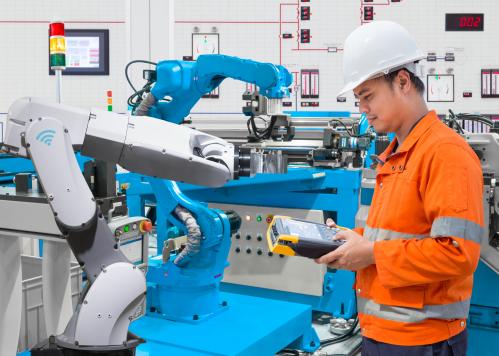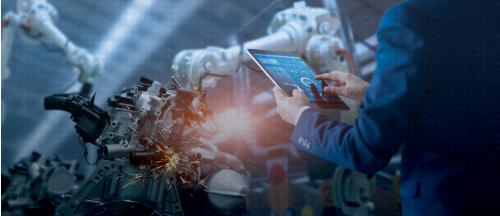Last month, we released research that suggests the next phases of workplace automation should be manageable for most workers, with only a quarter of the American workforce facing “high” exposure to automation technologies in the coming decades.
But that doesn’t mean the problem is insignificant. A quarter of the U.S. workforce consists of some 36 million people who will be highly exposed to automation, and could suffer displacement as a result.
The clear implication: Don’t expect this issue to sort itself out on its own. Indeed, even the Trump Administration acknowledged as much in its recent executive order on artificial intelligence (AI). While the executive order is light on details, it does direct the intergovernmental Select Committee on Artificial Intelligence to provide recommendations “regarding AI-related educational and workforce development considerations.”
What might some of these considerations look like? In our new report, we offer strategies for making the best of the automation era in the form of five major agendas to help maximize the benefits that automation and AI may bring, while mitigating the potential harms.
First among our proposed strategies is for the nation to run a full-employment economy, and, in general, to embrace growth and technology. In doing so, workers will have an easier time maintaining employment or transitioning from one job to another in conditions of widespread hiring. But beyond that, embracing, rather than resisting, the coming generations of digital technology—from automation and data analytics to various forms of AI—will likely help create new jobs and maintain living standards for many workers. Over the past 30 years, technology has been a significant source of new job creation and opportunity.
Furthermore, new technologies increase the productivity of the workers they do not displace, which in turn raises those workers’ wages and increases demand for other work across the economy. For this reason, the U.S. must step up its funding for R&D on emerging technologies like AI, big data, and super-computing, with an emphasis on leading global efforts to develop these technologies ethically and humanely. Through such investment, the U.S. can promote further job creation while securing global leadership in standard settings. That matters doubly because to cede such leadership to autocratic nations like China would be a disaster for human rights.
But the nation and its workers will need more than just a sufficient rate of job creation to offset the likelihood of job destruction. Even in the best of times, many, if not most, workers will strain to manage the coming necessary adjustments as automation and AI change or eliminate many jobs, while simultaneously creating new ones. In preparation for the changes to come, the nation needs to make a more serious commitment to helping workers and communities adjust, and to reducing hardships for those who are struggling. Here are four priorities:
Promote a constant learning mindset
Nearly all workers are likely to see some task change in their jobs—just think of how the emergence and widespread adoption of the personal computer over the past 30 years has affected nearly every worker. To adapt to coming changes, workers will need more support for skill development. Unfortunately, employer-supported training, one of the main forms of skill development for incumbent workers, has been declining over time:

Furthermore, we no longer have a clear idea of how many workers receive on-the-job training. The U.S. Census Bureau’s Survey of Income and Program Participation, which has provided this data in the past, did not collect any information about on-the-job or employer-sponsored training in its most recent panel in 2014.
But businesses must not be let off the hook—more firms must do their part to offer employer-led trainings or provide tuition or other skill-development benefits. Policymakers, in turn, can take steps to incentivize companies to increase training efforts, such as human development tax credits or lifelong learning accounts. Policymakers should also explore the viability of new learning models such as accelerated learning and experiential learning. And across all levels, education and training efforts should impart durable skills to help individuals both work with machines, as well as do what machines cannot.
Facilitate smoother adjustment
While our analysis shows that just 25 percent of U.S. jobs are highly exposed to automation, that still equates to over 36 million workers. Many of those workers—as well as some workers who are less exposed—may lose their job completely. However, the current worker adjustment system in the United States is wholly inadequate. As a portion of our economy, we spend less than nearly every other industrialized country on so-called active labor market policies (ALMPs) that help train workers and match them to jobs:

Furthermore, we invest less than we used to in these policies—as a percentage of GDP, we spend less than half of what we spent in 1985:

To reverse this trend, policymakers should increase funding for active labor market policies. However, just increasing funding indiscriminately is not enough. To best support worker adjustment, policymakers should create a Universal Adjustment Benefit that would help all displaced workers. Such a program would be anchored by three core components:
- Automatic enrollment in career counseling for every displaced worker
- Expanded training access for all dislocated workers
- Robust income support for workers in training
Reduce hardships for workers who are struggling
Automation and AI will exacerbate financial insecurity by forcing many workers into low-wage work. It will be necessary for policymakers to take steps to reduce financial uncertainty and volatility. Policymakers should expand the earned income tax credit (EITC) (and issue payments quarterly or monthly) and enact a wage insurance program so workers forced into lower paying jobs can better make ends meet. Meanwhile, policies like state-run individual retirement accounts (IRAs), paid sick and family leave for all workers, and public healthcare options can provide workers in low-wage jobs a modicum of financial security.
For places like the small cities and rural areas that are at the highest risk from automation, even deeper investments will be necessary. Policymakers must help pivot these economies from the industries of the past to the industries of the future. They should boost the adoption of new, intelligent technologies by firms in hard-hit regional economies, as well as expand support for community adjustment efforts. One way to do so would be to provide extensive support for a group of small-to-medium-sized metros to serve as regional “growth poles.” Finally, policymakers and companies must future-proof regional workforces through, for example, specialized training modules that develop the skills that lead to automation-resilient work.
As evidenced by ongoing discussions in the business community, companies have fully committed to a new wave of automation. Doing so makes business sense—it will help bolster firm productivity and improve companies’ bottom lines. However, these decisions will also have significant impacts on the lives of millions of workers. Therefore, policymakers at all levels must step in with new investments to mitigate the worst impacts of automation, and to ensure a just and equitable transition to a 21st century economy. Without urgent and consequential action, we should expect the coming decades to look much like the last: considerable economic benefits for some, but significant strain and disruption for many others.
The Brookings Institution is committed to quality, independence, and impact.
We are supported by a diverse array of funders. In line with our values and policies, each Brookings publication represents the sole views of its author(s).








Commentary
Automation and AI will disrupt the American labor force. Here’s how we can protect workers
February 25, 2019